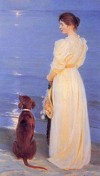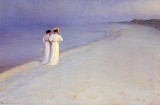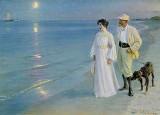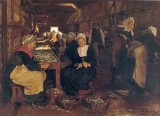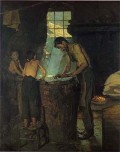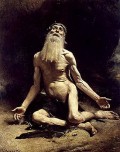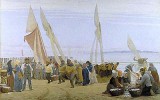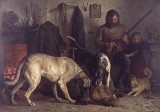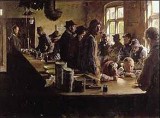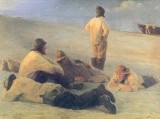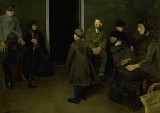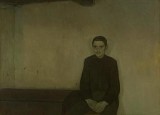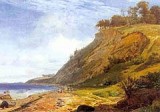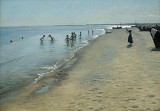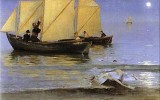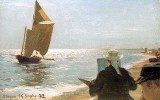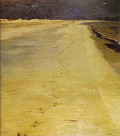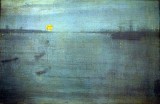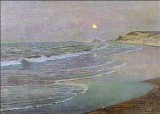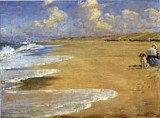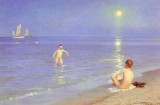The browser will either open the file, download it, or display a dialog.
All photographs taken by the author with permission of the Musée Fabre.
The Danish painter Peder Severin Krøyer (1851–1909) is best known for the landscape and figural paintings he produced as a member of the fin-de-siècle art colony in Skagen, Denmark, (figs. 1–3) and it was in significant part due to Krøyer's stylishly elegant images of its recreational life that Skagen emerged in the 1880s and 1890s as a world-renowned summer beach resort. In Krøyer's paintings, the once threatening waters of the Kattegat Sea were tamed into a glistening backdrop for the evening promenades of pretty people and the splashing amusements of playful children. It was Krøyer, explains art historian Elisabeth Fabritius, who was the leading shaper of "the myth of Skagen as a synonym for sun and summer fun, partying and youth, happiness and the idyll of sun-lit summer nights."[1] This mood of reverie and nostalgia has inflected the language of Krøyer's reception since his lifetime and has made him one of the more romanticized figures in the history of nineteenth-century Danish art. The following analysis of Krøyer's Skagen paintings offers an urgently needed corrective to this image of the artist.
The combination of Krøyer's technical bravado and the persistent appeal of his Skagen imagery have made it difficult for art scholars in Denmark to resist him; at the same time, however, the frivolity of content in his paintings has left scholars reticent to give him full credit for his creative enterprise. When the question of substance in Krøyer's paintings is taken up, the reference is often somewhat apologetic. "Krøyer is so masterly in his handling," wrote Krøyer's contemporary N. V. Dorph in 1902, "that he would have to reach great heights to match it with content of commensurate significance. And those heights, he never reaches. There is an undeniable disparity between spirit and hand in Krøyer's art."[2] Many art writers[3] have thus turned to the subject of Krøyer's life story, perhaps because its melancholy fate contrasted in such a satisfactory way with the carefree hedonism of his paintings.[4] Krøyer, in these narratives, was the virtuoso painter of light who ended his life in blindness: the popular, gregarious genius who loved to socialize and yet died broken and alone. A widely cherished profile of Krøyer has thus emerged whereby he is seen as a born master with a love of life who painted largely because he was so good at it.
The resulting deficiency in analytical rigor has had serious consequences for Krøyer scholarship, particularly in under-estimating his creative agency. As art historian and curator Annette Johansen observes, Krøyer's oeuvre "simply gave the impression that motifs didn't matter to him, as such, because it was only the painterly process that interested him. Traces of painterly technique in his work were perceived as expressions of superficiality, and that criticism persists to this day."[5] The traces to which Johansen refers are primarily the anti-classical approaches to painting that Krøyer learned during his first extended study trip in France. Importantly, Johansen demonstrates that these early flourishes were not mere dabblings, but rather indications of Krøyer's desire to affect a more modern (read French) style of painting.[6] The present study builds on Johansen's findings to propose that Krøyer's formal experimentations were part of a larger representational strategy, one developed over the course of several years, which came to fruition in his landscapes and figural paintings from Skagen.
Krøyer emerged as the most influential of Skagen's art-colonists almost immediately upon his arrival there, in 1882. This was in large part due to the notoriety he had already achieved before he joined the colony.[7] A precocious talent, Krøyer had graduated from the Danish Royal Academy of Fine Arts in 1870 at the unusually young age of nineteen, and had proceeded to gain a reputation as Denmark's most promising painter. Particularly important to this, beyond the praise he regularly received at the annual Academy exhibition in Copenhagen, was the success that Krøyer experienced beyond Denmark's borders.[8] Krøyer made his Parisian debut at the Salon of 1880, where his A Sardine Works in Concarneau (fig. 4) and French Forest Workers (1879) received favorable reviews in both the Parisian and Danish presses, and he enjoyed a similar success in the next year with his Italian Fieldworkers (1880).[9] When Italian Village Hatters (fig. 5) was given Third Prize at the Salon of 1881, he became the first Danish artist ever to receive an award at the Paris Salon. Official endorsement by the Parisian establishment was surely an encouraging sign for Krøyer's prospects; in Copenhagen, however, it seemed also to be perceived as a watershed moment for Danish art, in general. Increasingly through the 1870s, and regularly by the early 1880s, Krøyer was being spoken and written of as a standard-bearer for the revival of the Danish school.[10] The period of the 1870s and 1880s has come to be remembered as Denmark's "modern breakthrough"; and, as art historian Eigil Brünniche recounts, "Krøyer returned to Denmark in 1881 and took his place as [its] trailblazer."[11]
What resonated with Krøyer's Copenhagen audience was his incorporation of the stylistic innovations he had learned during his tour of the continent, particularly as a student in the atelier of Léon Bonnat (1833–1922).[12] Krøyer began studying with Bonnat immediately upon his arrival in Paris, in 1877, and although Bonnat was hardly at the stylistic vanguard by French standards, his relentlessly visceral realism and expressive use of lighting were radical in comparison to the staid and anecdotal realism taught at the Academy in Copenhagen (more on which below). With works such as the impressive Job (fig. 6), Bonnat fell squarely within the trend of demythologized and objectivized historical realism that had been inspired by Ernst Renan's scandalous bestseller, The Life of Jesus, of 1863. The ferocious anatomical honesty with which Job's body is depicted, the stark chiaroscuro that at once isolates him from his own setting and leaves him utterly at the mercy of God: these were stylistic strategies unfamiliar to Krøyer. Krøyer's 1875 Morning at Hornbæk, Fishermen Returning to Shore (fig. 7), for instance, demonstrates the heavy stability of plain-parallel design, modest ranges in palette and lighting, and anecdotal narrative for which his Academy training had taught him to strive. In early French efforts such as A Sardine Works, Krøyer seemed to be making his first, tentative approach toward a sober realism more in line with Bonnat's. The primary achievement of A Sardine Works was in Krøyer's presentation of a working scene without a supporting narrative to engage or entertain the viewer. While peasants and other workers certainly made regular appearances in Danish painting of this period, the reality of their existence was sometimes modified by a vague rhetoric of national romanticism or moral fortitude. For example, while the muted palette and somewhat stale atmosphere of Otto Bache's After the Boar Hunt (fig. 8) depicts a dim life of poverty, the scene itself is nonetheless offered in pleasant, anecdotal form, as the family dogs are sampling the day's spoils and a plump and innocent daughter affectionately clings to her stalwart father's side. In A Sardine Works, by contrast, Krøyer depicts a line of women at work, and just that. Instead of a narrative supplement to maintain the viewer's interest, Krøyer uses varying intensities of light (the primary legacy, in Krøyer's oeuvre, of Bonnat's instruction) to counteract the monotony of the scene's construction and suggest a perspectival line of sight to the viewer.
To understand the full significance of Krøyer's international success, and the near reverence with which he was embraced in Danish art circles, account must be taken of the rather depressed state into which Danish art had fallen in the preceding decades. The period roughly between 1815 and 1850, often referred to as Denmark's "Golden Age," had seen a remarkable flourishing of successful creativity in all areas of the arts. In painting, the age was characterized by the emergence and refinement of a highly perceptual and meticulously finished naturalism, which was applied not only to representations of nature but, with equal success, to genre depictions of everyday life.[13] Christoffer Wilhelm Eckersberg (1783–1853), perhaps the most successful painter of the period, exerted a towering influence as a professor at the Academy. A primary pedagogical goal for Eckersberg was to instill in his pupils a profound respect for humility, simplicity, and order in painting, the last of these structurally based on an elaborate perspective system that he developed over several years and published under the title A Guidebook in the Use of Liner Perspective for Young Painters, in 1833.[14] No less important was the premise that it was the artist's duty to improve upon nature: to capture and accentuate the essence of a natural scene through a supreme clarity of focus on individual objects (even those in the far distance of pictorial space) and the superimposition upon those objects of a stable compositional order (even where such was lacking in the actual landscape being depicted).[15] Through the 1830s and 1840s, Eckersberg's students were thus engaged in the quest to achieve an exquisite and vibrant naturalism in which everything in sight was valued for its contribution to a living and unified whole. "Let us with assiduity scrutinize Nature's Great Book," exhorted Eckersberg; "let us endeavor to eradicate all kinds of prejudice and seek out the nearest path to the goal – namely Truth!"[16]
With Eckersberg's death in 1853, the momentum of innovation and experimentation that he had fostered slowly dissipated and, with several untimely deaths amongst the leaders of the younger generation of graduates, the Academy was severely hampered in its mission of providing new instructional guidance.[17] From the 1850s and through to Krøyer's student days, Academy training was more often directed toward replicating the apex of Golden-Age naturalism rather than toward transcending this heritage or forging new interests. The result was an approach to painting that idealized clarity and detail at the expense of atmosphere and mood. Eckersberg's valorization of fidelity to nature had devolved into a philosophy that defined nature concretely as the realm of material objects and insisted that those objects be meticulously, clearly, and equally represented. This approach in turn dictated a pictorial system in which light was soft (if not universal) and the air around material objects did nothing to obfuscate their focus. Thus, what had been Eckersberg's refreshingly novel art of the everyday had in his absence become a banal and fastidious art of the trivial. By the late 1870s, art critics and observers in Copenhagen were expressing a growing dissatisfaction with the stiff and tired stagnancy of the Academy.[18]
The situation came to a head with the 1878 International Exposition in Paris, which, according to Brünniche, "became the single worst fiasco that Danish art had experienced in an international forum, to that point."[19] Since the International Exhibition of 1855, Danish selection committees had tended to assign a low priority to the fine arts, rather favoring the applied arts and technology as indices of national achievement. In 1878, things were to be different: "It was visual art," explains Sigurd Schulz, "that was to wave the Danish flag."[20] Notwithstanding this vote of confidence, however, the exhibition committee nonetheless hedged its bet in fateful ways. Unwilling to bank its reputation on the younger generation, the committee chose to lead with its dead masters. Golden-Age painters Wilhelm Marstrand (d. 1873) and P. C. Skovgaard (d. 1875) were granted feature status, and while there were also some works by living artists on display, the general mood of the exhibit was one of decline.[21] Nor were the relatively few contributions by Denmark's current artists sufficiently refreshing to infuse a sense of vitality. The French critics held nothing back in articulating their conclusion that Copenhagen had lost itself in the Biedermeier dream and was wallowing in a bland, bourgeois provinciality. Writing for the Gazette des Beaux-Arts, Edmond Duranty found the Danish exhibit "painstaking, meticulous, cold, and dry,"[22] and Charles Blanc went so far as to quip that while Denmark "appears to have artists, it has no art."[23]
In September of 1878, Danish painter and exhibition jury-member Lorenz Frølich (1820–1908) published an informal review of the Danish exhibit. He opened on a comforting note, relating his feelings upon arriving in the Danish hall, his mind alive with the various impressions he had gathered from the art of other nations on display. It was like being at home again: "amongst familiar, well-known scenes that we look upon as good friends." He then took the opportunity to offer a gentle but important suggestion. "I am in no way ashamed of our country's art," Frølich assured his readers.
I happily identify myself with it, though I realize from the Danish papers recently that not everyone feels that way … It's plain enough that many other places show advances that we have not yet reached, and a greater freedom and variety in our art would surely be beneficial. My only wish, therefore, is that our artists have the opportunity to learn about current artistic developments in other countries … Learning from past masters will surely yield significant benefits, but to absorb and incorporate the developments of today is usually the more natural approach. Very few speak the language of the dead.[24]
The most serious problem was not what was being taught at the Copenhagen Academy, but what had been systematically omitted from instruction. Danish art had isolated itself almost entirely from developments on the continent. "Unconcerned with our relationship to art in the rest of Europe," related Sigurd Müller in 1881, "we consoled ourselves with the thought that foreigners were equally indifferent to our intimacy and integrity, our pursuit of unadorned truth."[25] After 1878, the unadorned truth appeared to be that Danish art was well behind the times: Courbet's attack on the grand manner and the Impressionists' deconstructions of light and opticality had passed largely without notice.
Ironically, while Eckersberg was still seen as the great master whose creative heights Denmark's subsequent painters had failed to regain, it was partly Eckersberg's own legacy that had dictated their eventual bankruptcy. As Kasper Monrad notes, "Eckersberg himself lost contact with artistic life outside Denmark. Even though he had studied in Paris … and spent three crucial years in Rome, in practice he did not go abroad again" after 1816.[26] Of more profound consequence was the national-romantic project of formulating a Danish school of art, which was championed by both Eckersberg and the highly influential nationalist critic and Academy professor N. L. Høyen, and which had gained a wide influence at the Academy by the 1840s.[27] Inspired by Johann Gottfried Herder's notion of national genius, which attained a particularly wide currency at the Copenhagen Academy in the 1820s and 1830s,[28] the Academy propounded a national art that looked only to itself, to Denmark, and to the Danes, for inspiration and subject-matter. Additionally, this inclination toward ethnic solipsism was also central to the National-Liberal political party's culture of unity, which became especially difficult to resist after Denmark's resounding defeat by Prussia in the Second War of Schleswig, in 1864.[29] The result was a rigidly insular cultural program that exerted itself especially forcefully on the humanities and held its insularity to be its strongest virtue.
There had been agitations against this state of affairs before Krøyer's emergence, primarily by the extremely influential literary scholar and humanist Georg Brandes (1842–1927). Brandes inaugurated a series of public lectures in Copenhagen in the Fall of 1871 under the title "Central Themes in Nineteenth-Century Literature," in which he attacked the National-Liberals' right-wing nationalism on the grounds that it had resolutely turned its back on the advances of positivist humanism in favor of a reactionary, doctrinaire, and repressive conservatism. Brandes had witnessed the growth of a modern, free-thinking, empirical society in post-revolutionary Europe, "and believed that it was his generation's task to lead Denmark in the same direction."[30] Although political controversy prevented Brandes from ever receiving a post at the University of Copenhagen, he nonetheless managed—through his lectures and writings—to introduce the younger generation in Denmark to vanguard thinkers from throughout western Europe.[31] While Brandes was by far the more transformative figure, Krøyer's Parisian triumph caused a euphoria that projected hopes of similar reform onto him. By the early 1880s, Krøyer and Brandes were being regarded as the joint heads of Denmark's "modern breakthrough."[32] Krøyer's interest in the more radical expressions of this project, however, did not last long.
In the summer of 1880, during a visit to Sora di Campagna, Krøyer had begun work on a painting of an Italian hat-maker's workshop: "an extraordinarily painterly motif," as he wrote to a Danish colleague, "from which I expect a great deal and which I believe will be, without qualification, the best of my pictures this year."[33] While Italian Village Hatters certainly lived up to Krøyer's expectation, earning him a medal at the Paris Salon, it also generated a surprising storm of indignation when exhibited in Copenhagen later that year.[34] The painting was the boldest statement yet of Krøyer's dedication to the distilled realism he had learned from Bonnat. Interpreting Krøyer's work as a contemporary update of the Job motif, which Bonnat had painted earlier that year, art historian Peter Michael Hornung describes "a hat-maker whose life-sentence it was to make felt hats for well-off people who lived in blissful ignorance of just how such articles were made."[35] When the Danes saw it, they were appalled. Notwithstanding the collective wish, among Krøyer's fellow artists, for a fresh gust to blow away the fog of quaint romanticism that had settled over the Danish art scene, there were apparently limits to what could be tolerated by the art-going public in the short term. The painting was perceived as dirty, dreadful, and utterly un-charming.[36] Having been weaned on a romantic ideal, explained art historian Emil Hannover,
People were used to Italy's buxom girls, its fat monks … and had seen them so often, and depicted in so uniform a manner, that they counted on them as they did their own countrymen. Each year, a number of artists were sent down there; each year, they sent a piece of Italy back up here. It was so well understood, because it was so unfailingly Danish; even though not a single, southern-European sunbeam was captured on these canvases. And still, here at home, one believed that one knew Italy: that hanging at the Academy and at Thorvaldsen's Museum was a complete Italie illustrée.[37]
Audiences were simply shaken by the juxtaposition of beautiful Italy with the grimy heat of laboring poverty: "shocked," as Karl Madsen relates, "by the drop of sweat that hangs threateningly from the hat-maker's nose, over the felt that he rolls with his lean, sunburned hands."[38]
Hannover's remarks are interesting for their implication that what offended Krøyer's viewers—more than the jarring reality of the painting before them—was the artist's tacit critique of their Danishness: his implicative indictment of the isolationist, naive worldview it dictated. For a brief period after the Copenhagen debut of Village Hatters, Krøyer was popularly perceived not merely as a reformer, but as a revolutionary.[39] The extent to which Krøyer was affected by the Danish reception of Village Hatters is not known, but it does seem that the uproar caused him to pull back substantially on his approach to realism. There are clear traces of Krøyer's French and Italian experimentations in his early Skagen works—for instance, his painting In the Store During a Pause from Fishing (fig. 9) shows him working with techniques of perspective and lighting strongly reminiscent of A Sardine Works—but there are traces also of a slightly shaken compositional confidence. An unusual feature of A Sardine Works, in the context of Danish genre painting at the time, was that it did not ask the viewer to do anything more than simply to view: empathic participation was not required in order fully to experience the image. While Krøyer certainly invites the viewer to enter In the Store, he also seems somewhat tentative about how to do so. The primary moment of contact is with the off-putting and sullen gaze of the pipe-smoking fisherman, who leans mirthlessly against the bar as he waits for conditions to improve. Krøyer, however, has also painted two charming little children standing at the bar: a girl who gazes wistfully at the barman, and a boy who carefully observes the balance that the barman is using. This juxtaposition indicates Krøyer's struggle to reconcile his wish to say something substantive about the contingent quality of a fisherman's life with the practical need he apparently felt to temper this message with a conventional moral: in a generation, we are invited to imagine, it will be the little boy smoking the pipe, as he waits for the fish to return. Interestingly, a preparatory oil sketch for this work demonstrates that the pipe-smoker was originally absent from the composition,[40] suggesting that this figure was added to temper the viewer's comforting engagement with the scene at the anecdotal level. It may be observed that Krøyer provided a similar moment of eye-contact in Village Hatters, as the hatter's younger son momentarily looks up at us from the bleak center of his life's labor.
Whether because of reticence or because he had other concerns in mind, Krøyer also modified his representation of the laboring class. For when the fishermen emerged from the store, as in Fishermen on Skagen Beach, Late Summer Evening (fig. 10), it was not to return to a life of hardship. These fishermen seemed more to complement the landscape as embodiments of its majestic quietude than to engage it in battles for livelihood. Krøyer's Fishermen on Skagen Beach was precisely the sort of painting of which writer Walter Schwartz later warned art historians of Skagen to be suspicious. "Don't think that there was a population [in Skagen] that contentedly took what the sea had to offer," wrote Schwartz in 1933. "A mean and hard place was Skagen, where fear was the feeling one knew best."[41] The austere, leftist realism that may be said to have commenced in Denmark with Krøyer's Village Hatters continued to develop in the works of other artists, and continued to push the increasingly perforated boundaries of Golden-Age complacency—paintings such as Harald Slott-Møller's The Poor: The Waiting Room of Death (fig. 11) and Ejnar Nielsen's And in His Eyes I Saw Death (fig. 12) largely rejected the anecdotal moralizing of earlier peasant art and painted in its place images of circumstantial and material deprivation—but this trend was not to receive any further input from Krøyer.
That Krøyer never again produced anything of a socially conscientious nature after Village Hatters, however, does not mean that he altogether abandoned the modern stylistic techniques that he had learned and observed during his years in Europe, nor is it clear that he gave up the project of a programmatic motive for his work. Indeed, if there is a single feature or tendency that characterizes Krøyer's Skagen paintings, it is the effort he continually seemed to be making to negotiate the two poles of his artistic heritage: on the one hand, the stable, conservative romanticism of the Academy; on the other, the more experimental and dynamic compositional techniques of fin-de-siècle Paris. Krøyer, by far the most internationally active painter in Denmark, exhibited in Paris (at both the Champs-Elysées and Champ-de-Mars Salons) nearly as frequently as he did in Copenhagen from 1890 on, and his Skagen paintings strongly suggest that he was looking for a formal mode that would allow his pictures to be equally striking in both places.
Krøyer's strategic approach to the difficult task of pleasing the art-going publics in both Copenhagen and Paris can be traced to his earliest works at Skagen, in which he appears to be selectively incorporating markers of modern compositional design into works that are otherwise quite conservative in their content and form. For instance, the diagonal around which the compositions of both A Sardine Works and Italian Fieldworkers were organized became a standard device in Krøyer's Skagen beach scenes. While diagonal lines of sight were hardly new in Danish painting, it was comparatively rare for them to anchor a composition. When diagonals were present, they were more often implied than emphatic, and tended to be deployed for their didactic value, as in Johan Thomas Lundbye's A Danish Coast (fig. 13), where the diagonal line of sight joins Denmark's coast with the eternal realm of heaven. In Krøyer's Summer Day on Skagen's South Beach (fig. 14), the diagonal is neither an understated supplement to compositional design nor a device to assist in decoding the meaning of the work. It is a conscious break with the Golden Age emphasis on centralized perspective and plane-parallel distribution of pictorial space. Of critical importance is the fact that such examples of resistance in Krøyer's Skagen works were almost always compartmentalized as moments or pockets of formal experimentation within paintings otherwise quite in keeping with the post-Golden Age ideals of optical focus and perceptual clarity. No matter how aggressively Krøyer departed from the compositional principles he had learned in Copenhagen, he was never willing entirely to discard the general cleanliness of representation they were meant to perpetuate. Frølich's "good friends" were not to be cast off, but rather rehabilitated and redressed.
That Krøyer was attempting a negotiated formalistic update of academic plein air composition in Summer Day on Skagen's South Beach is forcefully demonstrated by a comparison to his 1875 Morning at Hornbæk, painted in another seaside town in Denmark, two years before his departure for Paris. In the earlier work, horizontal and vertical symmetry are firmly anchored by traditional compositional devices: the subject's view is toward a plane-parallel coastline, which reinforces the horizon line, which is reinforced in turn by the subtle stacking of wispy clouds above. It was a selective disruption of precisely this kind of structural order that Krøyer was attempting in Summer Day on Skagen's South Beach, painted nineteen years later. While the latter work resembles its predecessor in its attention to visual detail of objects (even those in distal pictorial space), it takes a different approach entirely to how those objects are distributed. Figural weight is cleared from the foreground of the composition of Summer Day and pushed well back into the upper half of the picture, and there is a noticeable horizontal imbalance, as well, between the loose grouping of ten boys who frolic in the water and the lone girl who gazes out, longing to join them.
Art historian Claus Olsen has suggested that the preoccupation with strong diagonals and unconventional pictorial balance in Krøyer's Skagen paintings may have reflected an influence of the Japanese visual æsthetic that had transformed Parisian modernism in the 1870s.[42] This observation, which seems quite valid, contributes to a common line of approach among scholars of Krøyer's Skagen oeuvre. Perhaps because Krøyer chose so resolutely to forsake controversial subject-matter, perhaps because his Skagen imagery was so innocuous, scholars have proceeded from the apparent assumption that Krøyer's employment of avant-garde compositional techniques simply reflected the influence on Krøyer of stylistic approaches that were in vogue in 1890s Paris. For instance, Jens Erik Sørensen has noted Krøyer's avid interest in photography and the less rigid attitude toward compositional framing and balance that it invited.[43] Probably before his arrival at Skagen, and certainly by the time he purchased his first camera in 1885, photographs were regular and integral preparatory devices in Krøyer's creative routine. Sørensen demonstrates that Krøyer was often attempting to capture in his paintings the accidental spirit of the spontaneous snapshot: in People of Skagen Set Sail for Night Fishing (fig. 15) the mast of the departing cutter is sliced through, as if by the frame of an unsteady viewfinder, and in Artists on Skagen's South Beach (fig. 16) the eponymous artists are very nearly cut out of the frame altogether.
Perhaps the most salient formal feature of Parisian modernism to be incorporated in Krøyer's Skagen works was the elasticity of pictorial space. In none of Krøyer's works was this effect more dramatically demonstrated than in the steep, shooting perspective of Skagen's South Beach (fig. 17). Only rarely was perspective space collapsed so strikingly in Krøyer's subsequent pictures, but the experiment did yield two other results that would become hallmarks of his most famous Skagen paintings: the high horizon line; and the vibrant, saturated color-palette that most prominently featured a moody, sensuous spectrum of blues. Indeed, the decade of the 1890s is known as Krøyer's "blue period," and it was in these paintings, more than any others, that Skagen took on the easy, sultry, stable, and timelessly beguiling mystique upon which its world-renown as a hedonist paradise would be predicated. In paintings such as Summer Evening at Skagen (fig. 1) and Summer Evening on Skagen's South Beach (fig. 2), Krøyer painted a world of silky atmosphere and cool reverie which, visually and emotively, was unique in the art of the colony. In reference to this informal group of pictures, and especially to works like Summer Evening on the Beach at Skagen (fig. 3) in which Krøyer features the moon rising over the water, Annette Johansen has remarked on the affinity of Krøyer's beach scenes with the stemningsmaleri (moody, atmospheric painting) that he had encountered in Paris. Krøyer had participated in the Exposition Internationale de Peinture at Gallerie Georges Petit, in 1885, and would therefore likely have seen a "Nocturne" by James A. M. Whistler, such as his Nocturne in Black and Gold: Entrance to Southampton Water (fig. 18), and a similarly solemn and brooding atmosphere regularly characterized the works of Thomas Alexander Harrison and Albert Besnard, both friends of Krøyer and successful fellow exhibitors at Champ-de-Mars throughout the 1890s.[44] As Johansen describes, paintings such as Harrison's Seascape, Moonlight (fig. 19) indicate a fascination for liminal times of day, for atmospheric phenomena that "blur the physical world and dissolve its contours." In this context, Krøyer's blue-toned Skagen paintings were "quite consistent with the tendencies of international painting of the time."[45]
The arguments presented by Olsen, Sørensen, Johansen, and others regarding possible sources of Krøyer's style are all convincing. That Krøyer was incorporating Parisian influences into his paintings in an effort to make them more modern for the sake of his Danish audience, certainly seems persuasive. And yet, these findings are not entirely satisfactory because: first, they do not recognize the extent to which Krøyer was also painting for his French audience; and second, they do not address the persistent grounding of Krøyer's images in the naturalist style of his Copenhagen Academy training. If Krøyer's quest for modernity was motivated by his belief in the Parisian avant-garde as the ultimate index of modernity, then why was his incorporation of it so tentative? Why did he adopt Parisian modernity as a catalogue of isolated compositional devices to be inserted into scenes whose opticality often suggested another philosophy of pictorial design altogether. Consider, for instance, the example of Krøyer's remarkable Marie Krøyer Painting on the Beach at Stenbjerg (fig. 20). It is clear that Krøyer was testing the boundaries of asymmetry in this work, but it is also interesting to note the rather conventional tenor of the painting as a whole. If Krøyer here had in mind the japonisme to which he was regularly exposed in Paris (as seems quite plausible) why did he not carry it through with the collapse of pictorial space and reductive depiction of objects that would have attended it: why the comforting regression of perspective space; why the expressive detail in waves and clouds?
For all of Krøyer's formal and compositional experimentations, he never allowed himself to forsake the steady sobriety of his academic roots. For instance, the pictorial space in Summer Evening at Skagen (fig. 1) is strangely distorted, an effect created by a wide perspective arc that sweeps out over the tide, and then sharply up to an unrealistically high horizon line. The objects that occupy this space, as well as the ground they stand on, however, are painted in a meticulously detailed and crisply realistic style. Similarly, the photographic spontaneity in People of Skagen Set Sail for Night Fishing is not reinforced or enhanced by a commensurately spontaneous lack of focus; indeed, the glassy blue water, the manta ray skeleton on the beach, and the two boats shoving off could hardly be more faithfully depicted. On the one hand, the apparent laziness of Krøyer's content has been perceived as a sort of failure to live up to his potential; on the other hand, Krøyer's abilities have been described as preternatural, portraying him as an artist who could do anything, faster and better than anyone else, without giving it a thought.[46] That a painter of such talent consistently squandered it on trivial motifs has in turn led to the image of Krøyer as an accidental genius: a good-hearted body with a gift; a reflector who painted by instinct and borrowed at random from those formal elements he saw in Paris.
It is argued here that Krøyer was trying to create a visual style calibrated to be effective not only in Copenhagen but in Paris, as well: a negotiated modernism that would be at once comfortingly familiar and intriguingly exotic to both audiences. "Krøyer has been written and spoken of a great deal," wrote Danish painter Lauritz Tuxen in a memorial shortly after Krøyer's death. "Not for nothing did his reputation precede him all over the world; not for nothing did friends and pupils, young and old, gather around him and acknowledge him as their standard-bearer."[47] Paintings that resembled those of other exhibitors might have been sufficient to earn Krøyer a place or two on the wall at the Champs-de-Mars, but they would hardly have caused him to be singled out, not only in Copenhagen but in Paris, as well. In a review of the 1900 International Exposition, French critic Camille Mauclair declared that "Denmark presents only one beautiful painter, but he is of considerable value: that is, Mr. Krøyer."[48] In the same year, critic Léonce Bénédite took it for granted that Krøyer was "the artist who is, without doubt, the most important figure in [the Danish] school."[49]
Krøyer's cautiously prospective style resonated deeply in Copenhagen because it had encouraged the hope that he would be the leader of an international future for Danish art. It seems that this hope resonated in Krøyer, as well. The dissatisfaction with the Copenhagen Academy that had been mounting in the 1870s reached a critical juncture in 1881, shortly after Krøyer's return to Copenhagen, when a group of artists and students proposed that an independent academy be founded and that its curriculum be based on the current Parisian model. The next year, Kunstnernes Frie Studieskoler was established in Copenhagen, with Krøyer and fellow Bonnat alumnus Laurits Tuxen as directors. Notwithstanding the merciless discipline of Krøyer's and Tuxen's pedagogical style, relates Hornung, students persevered "because what they learned, French valeur painting, was new, bold, and methodical" in comparison to what the Academy had offered.[50]
By 1888, Krøyer had already become the standard-bearer of the Danish school, and in that year he was appointed to the committee charged with organizing the contribution of Danish fine art to the 1889 International Exposition in Paris.[51] As he made clear in an uncommonly zealous letter to fellow artist and committee member Viggo Johansen, Krøyer deemed Denmark's international success in this venture to be of the utmost importance for the future. "Our art, like our country, is little by little becoming known in Europe," wrote Krøyer. "They are starting to notice and expect something of us. Let us now show that we deserve it; and let us show the very best that we have!" If the committee did not pull itself together and finalize its decisions, warned Krøyer, "I will regard it as a personal affront to me, particularly since I have told the French so much about what they will see when the Danes arrive!"[52]
It was Krøyer's wish—whether for the sake of his career or his country—to fashion a profile for Danish art on the continent, and the paintings of his blue period at Skagen were the primary submissions to this enterprise. Krøyer gave an indication of Skagen's significance for his art in a 1907 interview. "There is especially a mood I can't resist up at Skagen," explained Krøyer.
When the soft moonlight shines over the beach, I am there—immediately—with my sketchbook. Skagen can look terribly boring in broad daylight; when the weather is good, one sees the ugly, red-roofed houses. But when the sun is going down, when the moon is rising over the sea, hanging there, crystal-clear, and the water, smooth as glass, reflects its light, and then the fishermen standing on the beach and the cutters pushing out and sitting in the water with just a little slack in their sails … that has, in recent years, been my favorite moment.[53]
This statement, one of the most widely cited in the Krøyer literature, has usually been offered as evidence of Krøyer's sentimentality and appreciation of beautiful things. One may stipulate that Krøyer found beauty in the moment he described, but there is also evidence that he saw in it a highly evocative visual phenomenon of which he could make strategic use. One of the distinguishing features of Krøyer's blue paintings is his subtle depiction of precisely that moment when Skagen's sky is illuminated by two sources of natural light. Krøyer had painted this occurrence as early as 1884, in People of Skagen Set Sail for Night Fishing (fig. 15) . The source of light that is actually seen in this painting is not the key-light, but the filler. The scene is primarily illuminated by the sun, bathing the sails in a warm light as it sets behind us and out of frame; while over the sea, in the distance, an ivory moon offers a soft but unmistakable reply. Krøyer was apparently pleased with this mode of representing the simultaneous light sources; as he continued to work with this motif, it would almost always be the moon that was painted and the sun that was implied, as in the golden undulations of the woman's dress in Summer Evening at Skagen and the warm glow of bare skin in Boys Bathing on a Summer Evening on Skagen Beach (fig. 21). It is interesting to note that although the dual-light motif was an observable phenomenon at Skagen, none of the other colonists seemed to pay it much attention. Indeed, while Krøyer's Summer Evening on Skagen's South Beach (fig. 2) seems to have inspired the composition and tenor of fellow-colonist Michael Ancher's A Promenade on the Beach (fig. 22), Ancher pointedly avoided any reference to the blue-hour ambiance of Krøyer's painting by setting the scene at a much earlier time of day.
While Krøyer's blue-period paintings, particularly those that involved the dual-light motif, were important for the romantic appeal of Skagen in Denmark, they were of greater significance in distinguishing Krøyer's work, in the eyes of his Parisian audience, as peculiarly Danish. Krøyer's paintings did not merely enter or replicate the category of atmospheric landscapes that Whistler had mastered in the 1870s: while they passed fittingly into this group of pictures, they also enhanced and complicated it in unprecedented ways. While Whistler's "Nocturnes" were remarkable for their crystallization of a liminal moment in the familiar cycle of time, the simultaneously sun- and moonlit evenings in Krøyer's blue pictures seemed to render another kind of time, in which "the night approaches little by little, gradually, and the blue of the sky disintegrates. Everything is rendered to this effect with supreme surety and delicacy: the marine landscape, the ambiguity of the hour, the last rays of the disappearing sun."[54] Scenes such as Boys Bathing on a Summer Evening on Skagen Beach were layered in a rich natural light in which Maurice Hamel saw "the essential clarity of the north, that emerges from within."[55]
It is important to realize that the notion of a "mystic light of the North," which became a standardized European frame of reference to Scandinavian painting after the turn of the century, had not yet been reified when Krøyer first exhibited in Paris. The French critics in the 1880s clearly had a somewhat reductive view of Scandinavia, tending to think of artists from Denmark, Sweden, and Norway in regional group terms, rather than as nationals.[56] This regional stereotype, however, was based on romantic assumptions about an organic relationship to landscape engendered by a life lived on challenging terrain: naturo-symbolist fascinations with the midnight sun were not yet common currency in 1880s Paris. It is not claimed that Krøyer introduced the dual-light phenomenon to the Salon, but his depictions of it awakened a good deal of interest in his pictures, and curiosity about the place they represented. An example is found in a telling anecdote about Krøyer and the French painter Albert Besnard. As Annette Johansen relates, Krøyer and Besnard had met in Paris sometime in the early 1880s and maintained a close friendship, and active correspondence, until Krøyer's death. In an 1888 letter to Krøyer, Besnard recalls a pleasant visit that he and his wife had made to Denmark. What had particularly impressed them both were the late evenings: the mood, as Besnard added, that Krøyer captured so well on canvas.[57] Skagen's late, summer evenings allowed Krøyer to refine the hybrid international style which he had been developing since his arrival at the colony in 1882. It was a steady and unassuming pictorial language that managed to assert a version of French modernism in Copenhagen and a sophisticated and enchanting view of Denmark in Paris. The result was the pictorial group for which both he and Skagen became internationally famous.
Portions of this article were presented as conference papers at North and Nordicity, University of Toronto, 2007, and the Society for the Advancement of Scandinavian Studies international conference, Davenport, 2008. I gratefully acknowledge funding support from The Ambassador John L. Loeb, Jr. Foundation and The American-Scandinavian Foundation. I am grateful to Dr. David Jackson (University of Leeds) for his insightful comments on an earlier draft of this article. All translations into English are mine, unless otherwise noted.
[1] Elisabeth Fabritius, "Myten om Skagen," in Andrea Rygg Karberg and Christian Gether, Skagensmalerne – i nyt lys, exh. cat. (Ishøj: Arken Museum for Moderne Kunst, 2008), 47.
[2] Niels Vinding Dorph, "Danske Kunstnere XXVI: Peter S. Krøyer," Illustreret Tidende, January 12, 1902, 236.
[3] For instance, Knud Voss, Skagensmalerne (Copenhagen: Palle Fogtdal, 1986); Lise Svanholm, Malerne på Skagen (Copenhagen: Gyldendal, 2001); and Ernst Mentze, P.S. Krøyer: Kunstner af stort format – med brændte vinger (Copengahen: Det Schønbergske Forlag, 1980).
[4] Krøyer seems to have suffered from a borderline manic-depressive disorder for most of his adult life. In 1900, at the age of 49, Krøyer experienced a psychotic break that caused him to be hospitalized in the Psychiatric Ward of Middelfart Hospital, in Jutland. Though he survived the episode, Krøyer never fully recovered his psychological equilibrium, and subsequent breakdowns seriously hampered his productivity. In 1905, Krøyer's wife Marie left him to marry the Swedish composer Hugo Alfvén, with whom she had been having an affair since 1902. Krøyer continued to deteriorate over the next four years and died in 1909.
[5] Annette Johansen, "En Malerisk Odyssé: Om Krøyers store figurbilleder fra studierejsen 1877–81," Periskop, Forum for Kunsthistorisk Debat, no. 12 (2006): 24–25.
[6] Ibid., 11–25; and Annette Johansen, "Som sædvanlig har Paris gjort sin Virkning," in Harmoni i Blåt: P.S. Krøyers Stemningsmaleri i 1890erne, ed. Annette Johansen and Mette Bøgh Jensen, exh. cat. (Skagen: Skagen Museum, 2001), 57–66.
[7] Claus Olsen, "The Artists' Colony at Skagen," in Krøyer and the Artists' Colony at Skagen, ed. Bente Scavenius, exh. cat. (Dublin: The National Gallery of Ireland, 1998), 15–16.
[8] Johansen, "Som Sædvanlig har Paris gjort sin Virkning," 57–66.
[9] See Marquis de Chennevières, "Le Salon de 1880," Gazette des Beaux-Arts, 2nd ser., 22nd yr., 22 (1880): 41–70; and Sigurd Müller, "Peter Severin Krøyer," Illustreret Tidende, September 4, 1881, 606.
[10] Bente Scavenius, "Turn-of-the-century Art in Denmark," in Scavenius, Krøyer and the Artists' Colony at Skagen, 29–30.
[11] Eigil H. Brünniche, "P.S. Krøyer," Danmark, no. 5–6, 1946, 112.
[12] For Bonnat's significant influence on avant-garde painting in fin-de-siècle Denmark, see Sigurd Shultz, "Bonnats Skole" in Danske i Paris Gennem Tiderne, ed. Franz v. Jessen (Copenhagen: C. A. Reitzel, 1938), 2:447–54; and Finn T. Frederiksen, "Mødestedet Paris – Atelier Bonnat," in Mødestedet Paris: 1880ernes avant-garde, ed. Finn T. Frederiksen and Villads Villadsen, exh. cat. (Randers: Randers Kunstmuseum, 1983), 7–48.
[13] For a superb overview in English, see Patricia G. Berman, In Another Light: Danish Painting in the Nineteenth Century (New York: Vendome, 2007); see also Kasper Monrad, Danish Painting: The Golden Age, exh. cat. (London: The National Gallery, 1984); Catherine Johnston, Helmut R. Leppien, and Kasper Monrad, Baltic Light: Early Open-Air Painting in Denmark and North Germany, exh. cat. (New Haven: Yale University Press, 1999).
[14] Christoffer Wilhelm Eckerberg, Forsög til en Veiledning i Andvendelsen af Perspektivlæren for Unge Malere (Copenhagen: privately printed, 1833).
[15] For a general overview of Eckersberg's influence, see Philip Conisbee, Kasper Monrad, and Lene Bøgh Rønberg, Christoffer Wilhelm Eckersberg, 1783–1853, exh. cat. (Washington, D.C.: National Gallery of Art, 2003). Eckersberg's pedagogic innovations are detailed in Kasper Monrad, "The Nordic Contributions to Romanticism in the Visual Arts," European Review 8, no. 2 (2000): 173–83; Eckersberg's legacy, as evinced by the production of his most successful pupils, is the subject of Erik Fischer, ed., Eckersberg and His Pupils (Copenhagen: The National Gallery of Art, 1984).
[16] C. W. Eckersberg cited in Erik Fischer, Tegninger af C.W. Eckersberg, trans. Jan Smith (Copenhagen: Statens Museum for Kunst, 1983), 16. Also cited in Berman, In Another Light, 39.
[17] The year 1848, alone, saw the deaths of painters Martinus Rørbye (b. 1808) and J. T. Lundbye (b. 1818). Dankvart Dreyer, a landscape specialist, retired from painting around 1850, and died in 1852 at 36 years of age.
[18] See Peter Michael Hornung, Peder Severin Krøyer (Copenhagen: Palle Fogtdal, 2002), 151–59. For a history of the Royal Academy after the death of Eckersberg, see Peter Nørgaard Larsen, "Med Ryggen mod Fremtiden," in Kunstakademiet, 1754–2004, ed. Anneli Fuchs and Emma Salling (København: Det Kongelige Akademi for de Skønne Kunster, 2004), 1:119–86.
[19] Brünniche, "P.S. Krøyer," 110. See also Sigurd Schultz, "Verdensudstillingen 1878," in Jessen, Danske i Paris, 461–68.
[20] Schultz, "Verdensudstillingen 1878," 464.
[21] Writing ten years after the Exhibition, Karl Madsen revealed that the committee had flouted exhibition regulations by submitting paintings completed well before the early cut-off date of 1866, and had actually falsified the dates on some older works to ensure their inclusion. See ibid., 466.
[22] Edmond Duranty, "Exposition Universelle, Les Ecoles Etrangères de Peinture," Gazette des Beaux-Arts, 2nd ser., 20th yr., 17 (1878): 158.
[23] Charles Blanc, Les Beaux-Arts à L'Exposition Universelle de 1878 (Paris: Librarie Renouard, 1878), 342.
[24] Lorenz Frølich, "Nogle Ord om Kunsten paa Verdensudstillingen or særlig om den danske Afdeling," Ude og Hjemme, Nordisk Illustreret Ugeblad, September 8, 1878, 473.
[25] Müller, "Peter Severin Krøyer," 605.
[26] Monrad, "Nordic Contributions," 177.
[27] Berman, In Another Light, 95–104.
[28] Ibid.
[29] Steen Bo Frandsen, "The Discovery of Jutland: The Existence of a Regional Dimension in Denmark between 1814 and 1864," in European Identities: Cultural Diversity and Integration in Europe since 1700, ed. Nils Arne Sørensen (Odense: Odense University Press, 1995), 111–25. At stake in the Second Schleswig War (1864) were two Duchies—Schleswig and Holstein (Slesvig and Holsten, in Danish)—that had been subject to the Danish throne since the medieval period. Denmark wished to maintain its economic hold on Hamburg's trade, while Bismarck saw the opportunity of consolidating Germany's hopes of unification with a strong military showing. The war was brief, and the defeat of Denmark total. This episode is still regarded as the watershed moment in Denmark's history. The material losses were massive, including approximately one-third of Denmark's most arable land, but these were far outweighed by the fundamental trauma to the nation's collective psyche. Within a span of fifty years, Denmark had gone from a multi-national power with territories reaching from the Arctic Circle to the Elbe River, to a minor nation-state with no international relevance, at all. The Danish territory had been reduced to its smallest possible size, and, for the first time, the King of Denmark ruled over no subjects who were not ethnic Danes.
Paradoxically, this catastrophic period actually strengthened the Danish government's hold on both state and citizenry. Though the international posture of the state was deeply compromised, the nation it ruled over was extremely cohesive—a fact largely explained by the popular reaction, in Denmark, to its military defeat. The utter dissolution of Denmark's once powerful standing in the Baltic, combined with an unfamiliar territorial modesty, might easily have lead to feelings of resentment and outward aggression. Almost immediately, however, the consensus impulse was to forsake the world of power politics and build a new Denmark from what was left. A rousing couplet, formulated by land-reformer Enrico Dalgas, became the rallying cry for this project: "For every loss, some compensation may be found / What is outwardly lost, may be regained within." Dalgas's purpose was to encourage the development of Denmark's most promising resource—its arable land—but the ideological implication of his words was also quickly perceived. Danes were now united not only by citizenship, but by ethnicity, as well. As Henrik Stenius has observed, "individuals were citizens because people were similar to each other socially, ethnically, and religiously," and these bonds inspired the wish to define and understand what it meant to be Danish. Henrik Stenius, "The Good Life is a Life of Conformity," in The Cultural Construction of Norden, ed. Øystein Sørensen and Bo Stråth (Oslo: Scandinavian University Press, 1997), 167. Significantly, this desire was also a logical outgrowth of the cultural philosophy of the National-Liberal party's political agenda.
From their beginnings in the 1830s, the National-Liberals realized that the campaign to gain a constitution (which would be achieved in 1849) required reform of more than just the government. The Danish people, as well, had to be shaped into an electorate that could be relied upon to exercise political influence in an appropriate manner. To this end, the National-Liberals conceived a strategy to educate Danes not only on matters of policy, but on an entire way of life. Throughout the 1840s and 1850s, the party led an active campaign guided by the principle that, as party-leader Orla Lehman programmatically declared, "politics is the politics of culture." The consolidation of the electorate was pursued by inculcating the populace with a mobilizing sense of civic responsibility, which Lehman represented in terms of an institutional and comprehensive Danishness; as Steen Hvass and Stig Miss summarize it, "a culture of uniformity that comprised history, language, literature, religion, art, government, etc." Steen Hvass and Stig Miss, Orla Lehman – og den nationale kunst, exh. cat. (Vejle: Vejle Kulturhistorisk Museum and Vejle Kunstmueum, 1986), 9–10.
[30] Lise Busk-Jensen, "1870–1920," in Dansk Litteraturs historie, 1870–1920, ed. Klaus P. Mortensen and May Schack (Copenhagen: Gyldendalske Boghandel, Nordisk Forlag, 2009), 3:19.
[31] For example, Brandes's doctoral dissertation on the French critic and historian Hippolyte Taine had a strong influence on the development of naturalism in Scandinavian literature. Brandes was also an early translator of John Stuart Mill, and is generally credited with introducing Frederic Nietzsche to the Nordic readership.
[32] Brünniche, "P.S. Krøyer," 112.
[33] Letter from P. S. Krøyer to Frants Henningsen, dated "Sora di Campagna, August 15, 1880." Quoted in Hornung, Peder Severin Krøyer, 122.
[34] Scavenius, "Turn-of-the-Century Art in Denmark," 1998, 30.
[35] Hornung, Peder Severin Krøyer, 126.
[36] For a summary of reviews, see Johansen, "En Malerisk Odyssé," 22–23.
[37] Emil Hannover, "Lidt om Krøyer og den danske Malerkunst," Hjemme og Ude, no. 8, 1885, 101.
[38] Karl Madsen, "Krøyer," Gads Danske Magasin, January 1910, 205.
[39] Ibid.
[40] In the collection of the Ribe Museum of Fine Art, Ribe, Denmark.
[41] Walter Schwartz, "Der var et andet Skagen," Politiken, June 22, 1933.
[42] Claus Olsen, "Krøyer og det Japanske trasnit," in Johansen and Bøgh Jensen, Harmoni i Blåt, 77–82.
[43] Jens Erik Sørensen, "Tradition, Modernitet," in P.S. Krøyer: Tradition, Modernitet, ed. Jens Erik Sørensen and Erik Nørager Pedersen, exh. cat. (Aarhus: Aarhus Kunstmuseum, 1992), 44–67.
[44] Johansen, "Som Sædvanlig har Paris gjort sin Virkning," 60–61.
[45] Ibid.
[46] An insightful analysis of how this reputation contributed to the myth of genius that developed around Krøyer within his lifetime is provided in Mette Bøgh Jensen, At male sit privatliv: Skagensmalernes Selviscenesættelse (Skagen: Skagens Museum, 2005), 40–42.
[47] Lauritz Tuxen, "Erindringer om P.S. Krøyer," Kunstbladet, December 1909, 289.
[48] Camille Mauclair, "La Décennale Etrangère," La Grande Revue de l'Exposition, November 19, 1900, 179.
[49] Léonce Bénédite, "Les Arts á l'Exposition Universelle de 1900, l'Exposition Décennalle, La Peinture Etrangere," Gazette des Beaux-Arts, 3rd ser., 42nd yr., 24 (1900): 484.
[50] Hornung, Peder Severin Krøyer, 156.
[51] Ibid., 222–24.
[52] Letter from P. S. Krøyer to Viggo Johansen, January 11, 1889, quoted in Hornung, Peder Severin Krøyer, 223.
[53] Interview by C. C. Clausen conducted March 14, 1907, from the series "Stenografiske Interviews," Hver 8. Dag, March 24, 1907, 475.
[54] L. de Fourcard, "Le Salon de 1884," Gazette des beaux-arts, 2nd ser., 26th yr., 29 (1884): 476.
[55] Maurice Hamel, "Le Salon de 1887," Gazette des beaux-arts, 2nd ser., 29th yr., 35 (1887): 508.
[56] Michelle Facos, Thor J. Mednick, and Janet S. Rauscher, "National Identity in Nordic Art: Perceptions from Within and Without in 1889," Centropa 8, no. 3 (September 2008): 212–16, 219–21.
[57] Johansen and Bøgh Jensen, Harmoni i Blåt, 58–59.


